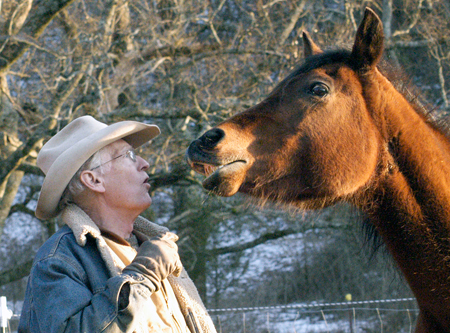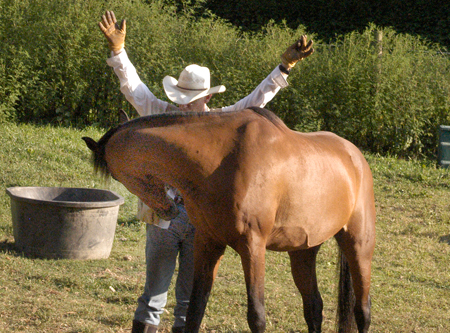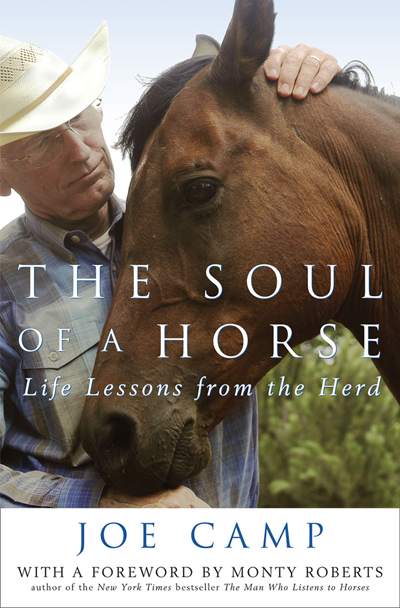I’m not a professional trainer. I do not do it for a living. But I am a student of what works. Logic and common sense, to a fault, I suppose. And the purpose of these concepts, and this page, is to provide some simple discoveries to folks who love their horses and want to give them an environment in which there can be real communication, understanding, structure, compassion, growth, and trust.
Twice every day when we go down to feed I’m faced with sorting out the horses to their respective feeding stations. Sometimes it takes no effort at all and other times it’s fruit-basket-turnover depending on who’s where, their individual moods, the weather, and whatever else is going on. Each horse is fed in a specific place, determined by his or her dominance position in the herd, but since we never use stalls, sorting them into those places is often… hmmm… interesting. The “places” and feeding order are determined by all kinds of things like who eats fast and who eats slowly, who is boss of who, and who is ornery enough to walk away from hers to steal someone else’s even before she’s finished. When we first moved to middle Tennessee I had to use halters to lead this horse that way and that horse this way. But a few weeks of that was quite enough. I decided to teach each horse to “walk with me” at liberty.
Wherever I wanted to go.
Whichever direction.
And however far.
A heady concept for sure. But a pretty cool thing if I could figure it out. This would be “liberty” at it’s best when you think about the complexity of communicating this objective to the horse. A horse who is not alone with you in some arena but has every possible distraction available, other horses, grass, weeds, whatever.
Enter treats.
And vocabulary.
Yes vocabulary!
Horses can learn the meanings of words and, like children, as their vocabulary grows they can put those words together into differing phrases and sentences. That’s not supposed to be true according to most, but Kathleen and I have found it to be absolutely true. And now there is even a scientific study proving it, discussed below.
But why would we fly in the face of virtually every trainer I’ve ever been exposed to who are all in lock step on the subject of treats. Use them minimally, and never as a training device. But when we discovered that training with treats not only enhanced communication, for the first time it gave our horses a way for them to speak to us, to initiate conversation… that’s when everything changed. With traditional training, we are always the ones doing the talking. Telling the horse, one way or another, to do this or do that. Never do we ask or listen to what the horse might want. And for the most part we teach with negative reinforcement. Release of pressure. In other words we stop doing something that is uncomfortable for the horse when he does something we’d like him to do. And we call it a reward.
Positive reinforcement would be something that the horse considers… well, positive. Good. Desired. Even fun.
Whoa! Hold on there. Have we stumbled onto something that actually teaches the horse and the horse enjoys it, thinks it’s fun?
Yes, we did.
And if the relationship is good, and your horse enjoys being around you, actually has fun with you, then halters and lead lines quickly become a thing of the past. We almost never fall back on them. All of our typical ground work we now do totally at liberty. And the leading byproduct of all this is trust. A horse at liberty trusts you more, because by allowing him to be at liberty you are trusting him more. He will never feel trapped by a rope. He will be there with you because he wants to be, not because he has to be. He has a choice in the matter. And when you boil it down, trust is safer than control.
So I began this Walk with Me project with Cash because I knew it wouldn’t take long with him and he would teach me what I needed to change to reach everyone else.
The first thing I taught Cash using treats was to smile.

Why? Because it’s quick, and simple, and establishes comprehension of concept: You do something I like and I’ll do something you like. Which can be quickly translated into: Hmmm… this works with a lot more things than just smiling. Even better it teaches them that they can ask for a treat politely without getting pushy or trying to steal from my pocket.
Now all of our horses do the smile. But teaching each one was a little different. We start with a treat grasped loosely in a closed hand, fingers facing the horse, up not down, the back of the hand facing us. Place your hand at about your own eye level. Let the horse smell that you have a treat. Say the word smile over and over. Big smile. Some horses need no more than this and will begin to “lip” your hand, opening their lips as they would when separating a piece of grass or hay. But don’t give the treat until the horse seriously lifts that upper lip way up. If that doesn’t happen begin to wiggle your index finger, sort of tickling the upper lip. This will help cause that upper lip to reach upward. And tells him that’s the body part you’re interested in. This finger movement will also become your visual cue. A quick point and upward wiggle of the index finger. With the word smile. I could get a smile from Cash from 10-15 feet away using the verbal and finger cue.
Whenever the horse does correctly, he gets an immediate “Good boy” plus the treat you hold in your hand. Some horses need to be tickled harder than others. With one, I had to reach out and actually lift the upper lip into smiling position before he understood.
Once Cash understood the word “up” I used that verbal cue to get his head or lip higher if necessary.

Then came walk with me. And the reward was the treat each horse received at the end of the walk. That kept them focused, and looking forward. The process began by urging just a couple of steps with the words, “Walk with me.” Rewarded by a treat. Then a few more steps. And finally walking to wherever I needed to take them. It blows most visitors away when I walk into the paddock and have horses come right up and say where are we walking to tonight? And then follow me off, very politely, through the round pen, or out into the western pasture, or through the barn into the rear paddock.

Every communication I’ve tried with any of our horses has shown better results faster using treats and words. So I admit it was nice to stumble upon a new scientific study reported by Discovery News verifying that horses are closer to people who treat them well, and the study praises the use of treats and words. Those who have read The Soul of a Horse understand why that gets a big Yippee! from me. We have known for some time that these findings regarding treats and words are true but so many folks preach “Never use treats” and even “Don’t talk to your horse” that it’s really nice to hear that what you believe and have proven to yourself to be true has finally been certified in a scientific manner. Now official so to speak. It made my day. I couldn’t wait to tell Cash.
When we are joined by a new horse, one of the first exercises we always teach in the round pen is to flex his head laterally all the away around until he is touching his rib cage. On both sides. We teach this using a halter and a lead rope, doing it over and over again until the horse flexes with virtually no pressure on the line at all. The purpose: it softens the horse in the neck and shoulders and, most importantly, the exercise is continued when in the saddle and it becomes so automatic to the horse that we now have a one-rein stop that doesn’t turn into a tug of war with a beastie six to eight times our size. An emergency brake so to speak.
One day recently I was playing with Cash and wondered if he would flex at liberty, without the halter and lead rope. It took less than sixty seconds for him to grasp the concept using treats and words I would hold the treat back against his rib cage saying, “Flex, Cash” and when he touched his side I’d give it to him. As soon as he got the picture, the cue became just a finger touch on his side with the word flex. And eventually just the word and maybe a point of the finger. And always a treat after. When I went to the other side I used the words “Now the other side. Flex, Cash.” That transitioned into merely reaching across his back to touch the “other” side, saying “Now the other side Cash. Flex. The other side.” And he does.

Most folks grow up assuming that the horse’s capacity to reason and his ability to have fun are just not part of his genetic make up. As we were beginning, unfortunately, those subjects just never came up. We never really thought about it. I was so focused on becoming one of the herd, using their language, directing them away from the reactive side of their brain, teaching them to move their various body parts – all of which is absolutely necessary to establishing a positive relationship with the horse, and necessary to clearly establishing my leadership role, which in the herd is based upon who moves who – that it just didn’t occur to me that a horse could reason, much like a dog can reason. Or that the horse could develop a verbal vocabulary, like Benji. The caveat is that all this basic training must come first, because neither reasoning nor vocabulary will occur unless the horse trusts you enough to stay on the thinking side of his brain, and trusts you enough to choose you as a herd leader. But all of that can be accomplished so much faster when done at liberty, when the horse has a choice in the matter.
Mustang Maddy (Madison Shambaugh) teaches unhandled mustangs fresh from the wild everything the horse needs to know up to and including riding the horse, all without a halter, leadrope, bridle or saddle. And using Positive Reinforcement (treats). Usually in a week or less. Completely at liberty. And she has videos of it all.
There’s simply no better feeling in the world than strolling along with your horse at your side… with no strings attached.
———–
Read about the one treat that is actually good for your horse
Read More About Horses, Benji, Goals in Life: joecamp.info
———–
The entire story of our journey with horses (at least through early 2019) is told in the two books that follow: the national best seller The Soul of a Horse – Life Lessons from the Herd and its sequel Born Wild – The Soul of a Horse.
And what a story it is as two novices without a clue stumble and bumble their way through the learning process so that hopefully you won’t have to. If you haven’t read both of these books already please do because with that reading, I believe, will come not just the knowledge of discovery but the passion and the excitement to cause you to commit to your journey with horses, to do for the horse without waiver so that your relationship and experience will be with loving, happy and healthy horses who are willing partners and who never stop trying for you. Horses like ours.
The highly acclaimed best selling sequel to the National Best Seller
The Soul of a Horse – Life Lessons from the Herd
#1 Amazon Best Seller
#1 Amazon “Hot New Releases”
Amazon & Kindle
B&N
Order Personally Inscribed Copies of Born Wild
Order Both The Soul of a Horse & Born Wild – Save 20%
Both Personally Inscribed
Please list the names for each inscription in the “instructions to Seller” field as you check out!
Read More About Born Wild
Read More About The Soul of a Horse
Watch The Soul of a Horse Trailer
Watch the Born Wild Trailer
But first read the National Best Seller that started it all
Now in it’s 17th printing:
Amazon & Kindle
Barnes & Noble
Order Personally Inscribed Copies of The Soul of a Horse
Order Both The Soul of a Horse & Born Wild – Save 20%
Both Personally Inscribed
Please list the names for each inscription in the “instructions to Seller” field as you check out!
Read More About Born Wild
Read More About The Soul of a Horse
Watch The Soul of a Horse Trailer
Watch the Born Wild Trailer
“Joe Camp is a master storyteller.” – The New York Times
“One cannot help be be touched by Camp’s love and sympathy for animals and by his eloquence on the subject.” – Michael Korda, The Washington Post
“Joe Camp is a natural when it comes to understanding how animals tick and a genius at telling us their story. His books are must-reads for those who love animals of any species.” – Monty Roberts – Author of New York Timers Best-seller The Man Who Listens to Horses
“Camp’s tightly-written, simply-designed and powerfully drawn chapters often read like short stories that flow from the heart.” Jack L. Kennedy – The Joplin Independent
“Joe Camp is a gifted storyteller and the results are magical. Joe entertains, educates and empowers, baring his own soul while articulating keystone principles of a modern revolution in horsemanship.” – Rick Lamb – TV/Radio host – The Horse Show
Visit The Soul of a Horse Channel on YouTube
Click any book cover below to read more or purchase
Follow our latest journey with two amazing new arrivals from the wild. Kathleen’s terrific photos are worth the click.
In chronological order:
What an Extraordinary Weekend!
Firestorm’s Amazing First Day in the Playpen
No-Agenda Time – So Much Value!
An Amazing Birthday Gift from a Wild Mustang!
Saffron and Firestorm – Progress and Photos – Lots of Both!
Two Mustangs – Three Mind-Boggling Months!
For more current posts go to the blog homepage and scroll down
Follow Our Entire Journey
From no horses and no clue to stumbling through mistakes, fear, fascination and frustration on a collision course with the ultimate discovery that something was very wrong in the world of horses.
Read the National Best Seller
The Soul of a Horse
Life Lessons from the Herd
Go to TheSoulOfaHorse.com Homepage
Visit The Soul of a Horse Channel on YouTube
Read More About Horses, Benji, Goals in Life: joecamp.info



